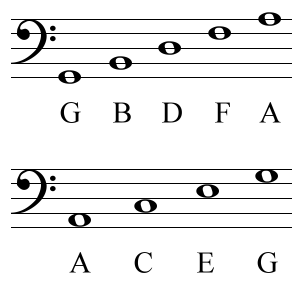
By Official LessonsOnTheWebOnline Piano Lesson VideosFollowMore by the author:
One of the first things that any beginning pianist learns to do, is to read music. Notes are the words that music uses to communicate with us, and in order to be able to read the language of music, we need to learn what the notes are so we can play them.
Here are some easy tips for learning your notes as a beginning pianist along with a video that offers some real time practice on your note reading that will help you improve quickly!Add TipAsk QuestionCommentDownload
Step 1: The Grand Staff

This is what we call the Grand Staff. You can see that there are lines and spaces on the top part as well as the bottom part. Notice the 2 different signs within the lines and spaces? These are called Clefs, and the top one is called the Treble Clef, and the bottom one is called the Bass Clef.
There are notes in each line and space in both the Treble and Bass Clefs. Let’s see what they are in the next step.Add TipAsk QuestionCommentDownload
Step 2: The Treble Clef and Notes in the Treble Clef

The Treble Clef contains 5 lines and 4 spaces in it, and each of these lines and spaces has a specific note that is located there.
The notes on the 4 spaces are F, A, C, & E.
The notes on the 5 lines are E, G, B, D, & F.
Say the note names on the Spaces going from the bottom to the top several times. Then do the same thing with the notes on the Lines, again going from the bottom to the top.
Now let’s look at the notes in the Bass Clef.Add TipAsk QuestionCommentDownload
Step 3: The Bass Clef and Notes in the Bass Clef

The Bass Clef also contains 5 lines and 4 spaces in it, and each of these lines and spaces has a specific note that is located there.
The notes on the 4 spaces are A, C, E, & G.
The notes on the 5 lines are G, B, D, F, & A.
Say the note names on the Spaces going from the bottom to the top several times. Then do the same thing with the notes on the Lines, again going from the bottom to the top.
Now let’s see what they look like together on the Grand Staff.Add TipAsk QuestionCommentDownload
Step 4: The Grand View of All Notes on the Lines and Spaces in Treble and Bass Clef

Here you have all of the notes on both the lines and spaces in each clef, for easy review. Take some time to read each note in each clef, and then try to look away and name all of your Space notes in each clef or all of your line notes in each clef.
Keep doing this each day until you can name the notes without looking at any hints.
**Remember to say in the beginning whether the note is on a line or on a space, as this will help reinforce that information in your brain and your fingers when you play it on the piano.
** Remember also, to always learn your notes from the bottom line or space to the top line or space in the clef that you are working in.Add TipAsk QuestionCommentDownload
Step 5: Ledger Lines

Ledger Lines are lines for notes that occur outside of the normal range for the Grand Staff. They are in both the Treble and Bass Clefs, and you won’t see them on your sheet music unless the piece requires you to play notes that are above or below the Grand Staff.
One of the most common notes that we all learn in the beginning, that is actually on a ledger line, is Middle C. Take a look at where Middle C is on the ledger lines in the next step.

